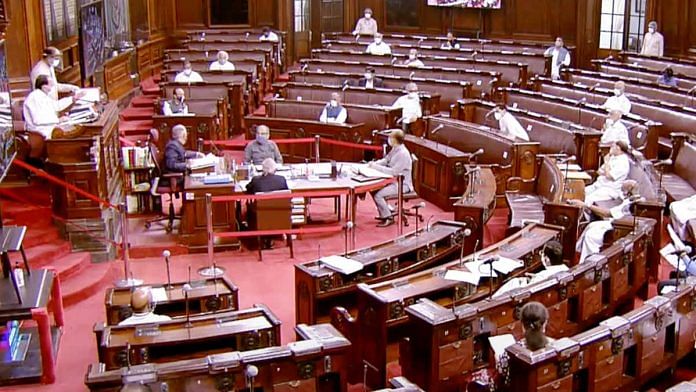Parliamentary sessions are an integral part of India’s democracy but very rarely have they generated the kind of attention, apprehension and curiosity among law-makers — as well as the public — as the ongoing monsoon session.
The most noticeable is the look inside the Rajya Sabha and the Lok Sabha. Members sit with polycarbonate sheets separating them, donning masks and gloves, and some even with head caps on. The scene inside Parliament looks surreal to say the least — triggered by the coronavirus pandemic.
Moreover, members of the Lok Sabha can be found sitting in the Rajya Sabha chamber and gallery, and vice versa.
But that is just one of the aspects that makes this monsoon session unique — and ThePrint’s Newsmaker of the Week.
Also read: Lockdown, migrants’ woes, ‘Trump link’ — 5 questions MPs want govt to answer on Covid crisis
The charged opposition
The months leading up the monsoon session have not been easy for India and its people. An unrelenting health crisis that brought a severe lockdown and saw many people dying and lakhs of them losing their job and livelihood was followed by a tense LAC standoff in Ladakh that hasn’t really abated yet. Now, there’s the issue related to the farmers. A charged-up opposition sought to corner the Modi government on its Covid-19 management, skirmishes at the Line of actual Control (LAC), farmers’ issue and the economy.
The government had to relent. Both Union Health Minister Harsh Vardhan and Defence Minister Rajnath Singh made statements on the floor of the House.
On the first day of the session, Prime Minister Narendra Modi, in his address to the media inside Parliament premises, said that the country stands behind the soldiers guarding India’s borders.
Two days later, Rajnath Singh made a statement on the LAC issue and said no force can stop Indian soldiers from patrolling along normal routes.
But one notable absence from the monsoon session has been Home Minister Amit Shah, who used to generally lead the government charge in Parliament. Recovering from Covid-19, Shah has not attended the session so far.
If Shah’s absence is being felt by the BJP, the Congress, the principal opposition party, too is missing its interim president Sonia Gandhi and MP Rahul Gandhi. Rahul has accompanied his mother abroad for her medical treatment.
What hasn’t changed about Parliament is the behaviour of MPs — the controversial remarks that they either later apologise for or get expunged from parliamentary records — the usual scenes of ruckus, and the adjournments. The Lok Sabha saw all of that Friday, closing the day with speaker Om Birla adjourning the House until 3pm Saturday.
Also read: Economy is an issue, but the venom against Nirmala Sitharaman is because she is a woman
The new norm
Among the many firsts this monsoon session is witnessing includes MPs addressing the House in a seated position. Traditionally, MPs stand when they address the House.
On their part, MPs have been cautious, keeping distance from each other. And why not — a mandatory RT-PCR test that each MP has to take before attending the session revealed that at least 30 of them were Covid positive.
MPs are getting used to talking with their mask on. The last five days saw both Lok Sabha speaker Om Birla and Rajya Sabha chairman M. Venkaiah Naidu frequently ticking off members for speaking with their mask pushed to the chin.
Members have also been barred from coming to the well of the House to protest or leaving their seats to talk to fellow colleagues. On Thursday, Naidu warned members in the Rajya Sabha against breaking the social distancing protocols. He said if members have to communicate anything urgent to their colleagues, they should write chits instead of leaving their seats.
While the Rajya Sabha meets for four hours in the morning, the Lok Sabha meets for four hours in the afternoon.
Parliament has also witnessed some light moments, due to the fact that members can now sit in either of the two Houses. In the Rajya Sabha, for instance, Naidu, after calling out a member’s name, has been often left searching on the giant screen placed inside the House to see if the member might be sitting in the Lok Sabha.
Also read: Positive in Delhi, negative in Jaipur — Nagaur MP’s curious Covid reports
The questionable move
Five days into the session that started September 14, Union minister Harsimrat Kaur Badal representing the Bharatiya Janata Party (BJP)’s oldest ally, Shiromani Akali Dal (SAD), resigned from Modi’s cabinet in protest against the three farm bills that Parliament has passed.
But even before the monsoon session began, the Narendra Modi government’s move to suspend the mandatory Question Hour, where MPs cutting across party lines grill the government on pressing issues of public interest, had created a furore.
MPs from both Houses vociferously protested since they perceived it to be the government’s way to avoid answering questions over its Covid management, faltering economy and skirmishes with China on the LAC.
The government initially stood firm. Its logic — Question Hour would require the presence of a large number of officials of concerned ministries inside the two Houses of Parliament. It will jeopardise social distancing protocol.
However, a united opposition partially managed to put the Modi government on the back foot, forcing it to allow unstarred questions where MPs ask questions and instead of replying verbally, the concerned minister submits the answer in writing, which is laid on the floor of the House.
Views are personal.



